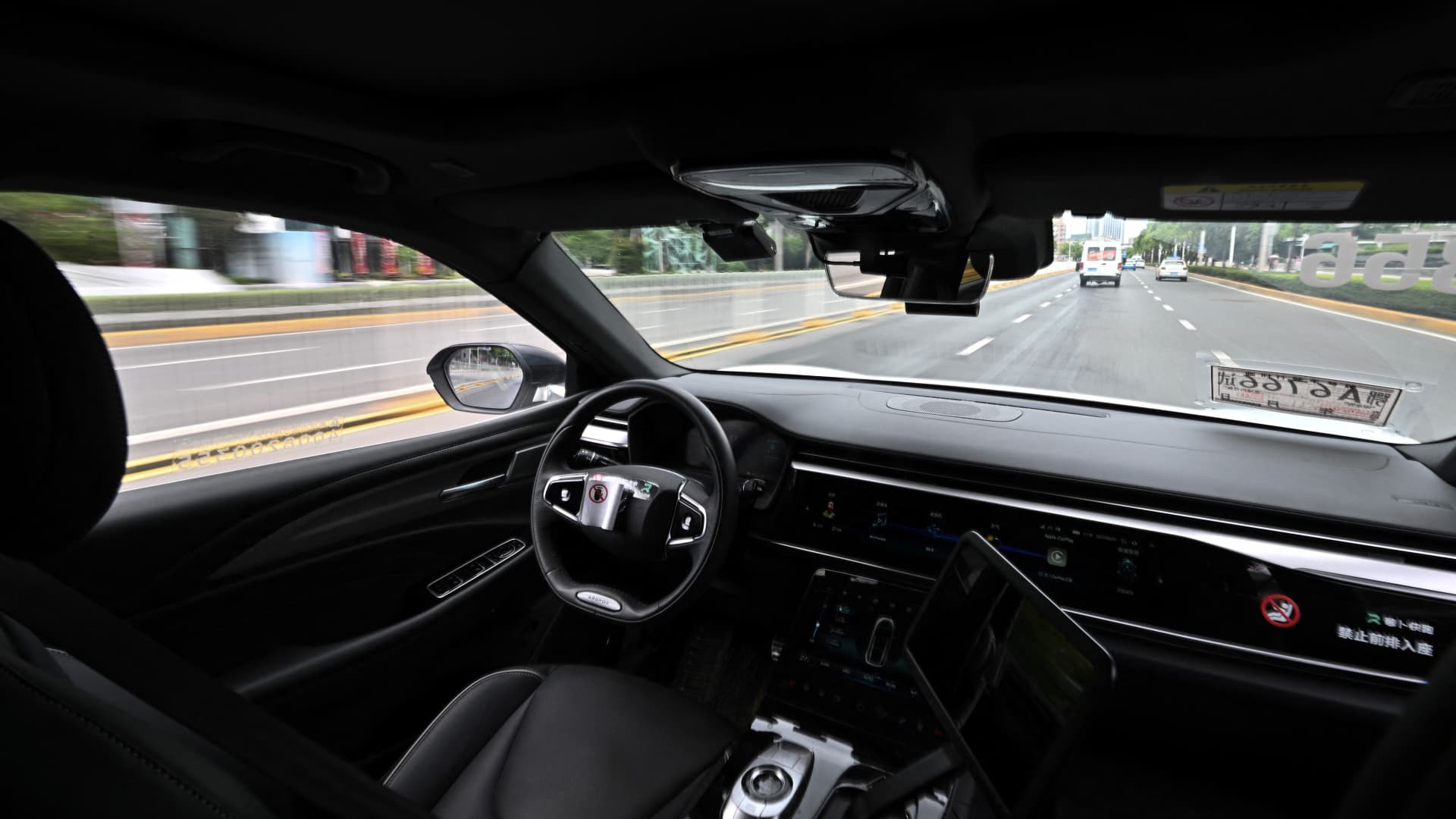TOPSHOT – The photo taken on August 1, 2024 shows a general view of the driver’s seat and controls of a driverless robotaxi autonomous vehicle developed as part of tech giant Baidu’s Apollo Go self-driving project, in Wuhan, in central China’s Hubei province. Turning heads as they cruise past office buildings and malls, driverless taxis are slowly spreading through Chinese cities, prompting both wariness and wonder. (Photo by Pedro PARDO / AFP) / To go with: CHINA-TECHNOLOGY-AUTOMOTIVE, FOCUS by Jing Xuan TENG (Photo by PEDRO PARDO/AFP via Getty Images)
Pedro Pardo | Afp | Getty Images
China’s robotaxi push is sparking job security fears among drivers, but experts say the technology is already creating new jobs.
On Tuesday, China issued 16,000 test licenses for autonomous vehicles and opened 32,000 kilometers of public test roads. In June, the government also greenlit nine domestic automakers, including BYD and Nio, to begin testing conditionally automated driving technologies on certain public roads. Elon Musk is looking to get regulatory approval for Tesla’s Full-Self Driving technology by the end of this year.
But all that action has led to many Chinese social media users saying autonomous driving is “snatching rice bowls” of drivers, or putting them out of work.
In the long run, autonomous driving will definitely displace the driver jobs. But again, there is already a shortage of drivers. So definitely, for the taxi [companies], you can see it’s a benefit for them.
Mohit Sharma
analyst, Counterpoint Research
Baidu’s self-driving ride hailing platform Apollo Go has around 400 robotaxis operating in Wuhan — its largest operational region — and plans to increase that to 1,000 by the end of the year. Robin Li, CEO of Baidu, said the firm’s share of Wuhan’s ride-hailing market is only about 1%.
“Scaling will be a gradual process and it could take many years,” Li said during the firm’s quarterly earnings call on Aug. 22.
The Apollo Go service became so popular that taxi drivers petitioned Wuhan’s transport authority to limit the use of the service, according to media reports.
A check on the Apollo Go app showed a 16-minute robotaxi ride within the southern suburb of Beijing suburb would cost 10.36 yuan ($1.46), about half the 20 yuan fare listed by ride-hailing apps, which can call taxis.
New jobs created
Despite the flurry of headlines, experts say autonomous mobility will mature gradually.
“You will not lose all the jobs in one go. It will be a slow transition phase area by area, region by region,” said Mohit Sharma, research analyst at Counterpoint Research.
He added that governments could collaborate with robotaxi companies to switch drivers to other jobs, while education systems can train new generations for the jobs of the future.
An Apollo Go spokesperson said the firm is committed toward creating new job opportunities in the ecosystem. Roles include those in monitoring and testing systems, as well as data annotation, the firm said.
Wang Juan, who has been working as an on-road testing operator at Apollo Go for about two years, told CNBC that she decided to join the industry because she was interested in it. On-road testing operators trial autonomous vehicles and provide feedback on problems encountered during the tests for optimization.
She used to work at an automaker but felt her career stagnated there. She jumped at the opportunity to work for Apollo Go instead.
“Very challenging. It’s very different from my previous job,” she said in Mandarin about her current role, translated by CNBC. “In this role, I seek to find the problems and issues with the autonomous cars.”
Jeff Farrah, CEO for the Autonomous Vehicle Industry Association, said the industry “is creating a wide variety of new, well-paying jobs” in the U.S. These roles include service technicians, remote assistance operators, mapping specialists, dispatchers and terminal operators, he said.
“Even though AVs perform all aspects of the driving task, workers are essential to the technology. It’s also important to remember that AVs’ increased accessibility benefits will help the disability community obtain new employment opportunities,” Farrah said.
While there is always some job displacement when new technology enters the market, Sharma agreed innovation will also “create more jobs and new jobs because of the technology.” Sharma named cybersecurity, vehicle testing and validation and software development as some of the opportunities.
“In the long run, autonomous driving will definitely displace the driver jobs. But again, there is already a shortage of drivers. So definitely, for the taxi [companies], you can see it’s a benefit for them,” he said.


– CNBC’s Evelyn Cheng contributed to this report.
Clarification: This story was revised to reflect Apollo Go’s updated count of robotaxis in Wuhan.















